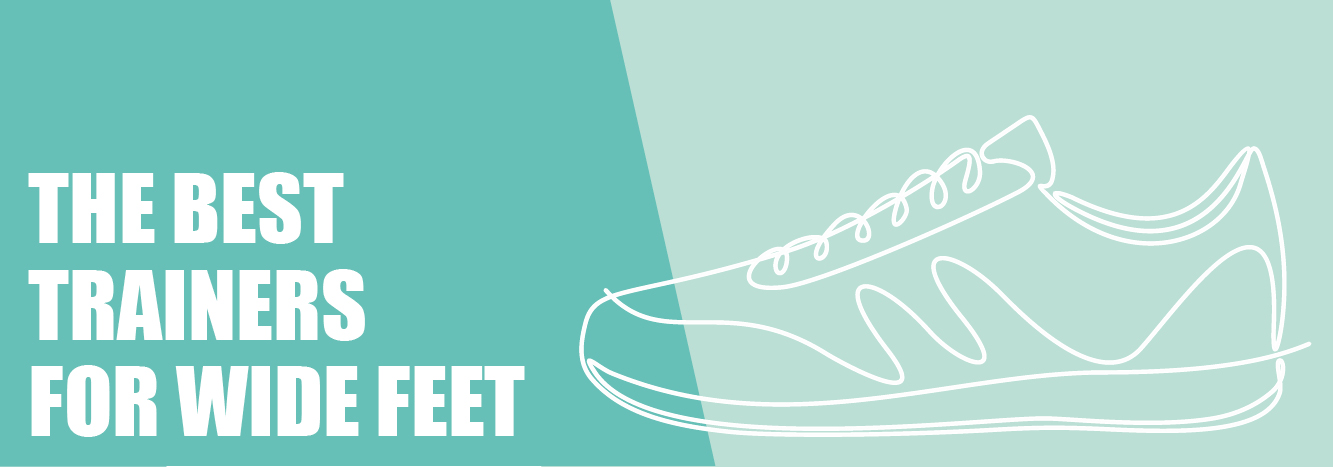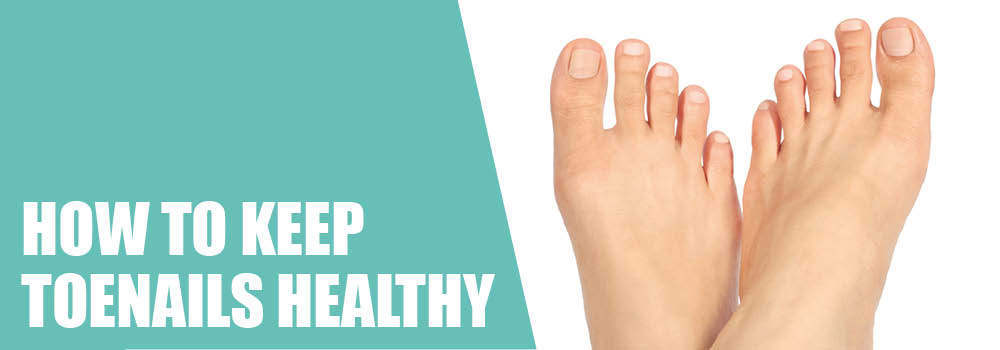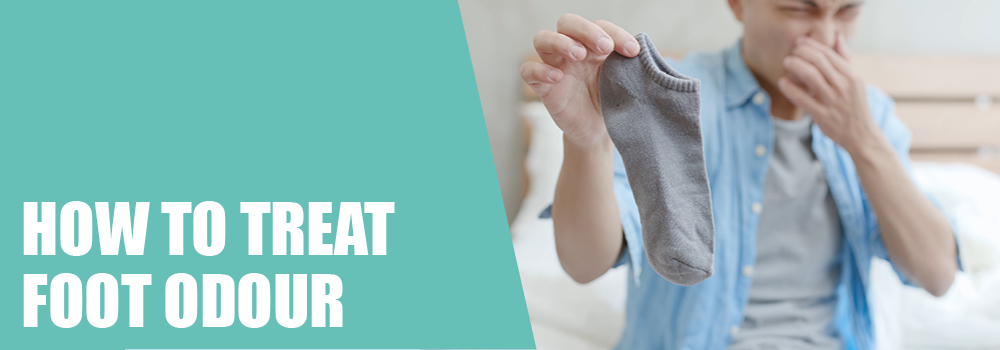8 Common Causes Of Arch Pain in the Foot
- Mrs G
- Simply Feet
- 18 May 2023
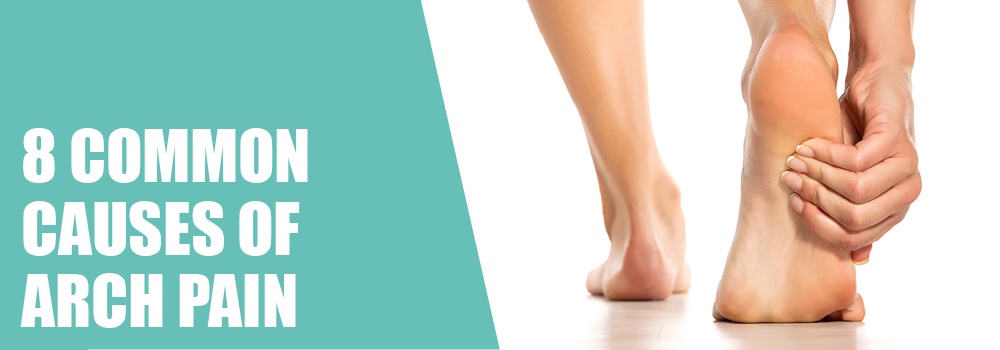
Dealing with pain in the arch of the foot can be both uncomfortable and disruptive to our daily lives. The foot arch plays a vital role in providing support, balance, and flexibility to our feet. However, several causes can lead to pain and discomfort in this area.
In this article, we will explore what causes pain in the arch of the foot, how to treat the causes and how you can prevent getting pain in your arch.
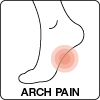

1. Plantar Fasciitis
Plantar fasciitis is a common condition that occurs when the plantar fascia becomes inflamed or irritated. The plantar fascia is a band of tissue that runs along the bottom of the foot from the heel to the toes. This condition often results in sharp, stabbing pains in the foot's arch, particularly when standing up after sitting for a long time.
You are more likely to develop plantar fasciitis if you:
- Are overweight
- Wear shoes with poor support and cushioning
- Overstretch the sole of your foot during exercise
- Are aged between 40 to 60 years old
- Recently started exercising on hard surfaces
- Increased the amount of activity you do, such as walking, running or standing up
Treatment for Plantar Fasciitis
Here are some of the ways that can help treat plantar fasciitis:
- Rest and elevate: when possible, try to rest and elevate your foot to reduce inflammation.
- Apply ice: icing your foot with an ice pack or frozen peas for up to 20 minutes every 2 to 3 hours will reduce swelling.
- Wear supportive shoes and insoles or heel pads: this will relieve pressure on your heel and give you extra cushioning and added support.
- Do regular stretching exercises: stretching and strengthening the plantar fascia will help relieve tightness, improve your condition and reduce the chances of developing this condition in the future.
- Over-the-counter medications: paracetamol and ibuprofen will help reduce pain and inflammation.
- Wear night splints: they are designed to keep your feet in place as you sleep, comfortably stretching the plantar fascia and reducing inflammation.
2. Muscle Strains
Muscle strains can also cause pain in the foot arch. The muscles in the foot that support the arch can become strained or pulled, causing pain and discomfort. This can happen from running, jumping, or even walking on uneven surfaces.
Treatment for Foot Muscle Strains
- Rest your foot: stop any exercise or activities and try not to put weight on the injury.
- Apply ice: apply an ice pack to the injury for up to 20 minutes every 2 to 3 hours.
- Keep it compressed: wrap a bandage around the injury to support it and keep it compressed.
- Elevate: keep your foot raised on a pillow as much as possible to help with the swelling.
3. Stress Fractures
A stress fracture is a small crack or break in a bone caused by repetitive stress or overuse, such as jumping or running. Stress fractures in the metatarsal and navicular bones can cause pain in the foot arch, and this can cause pain and discomfort.
Treatment for Stress Fractures
Firstly, it is best that you get examined by a doctor if you think you may have a stress fracture, and you should always follow your doctor's advice. However, here are some ways you can make sure you heal properly.
- Rest: stop any exercise or activities and try not to put weight on the injury if possible.
- Apply ice: icing your foot will reduce the swelling and relieve pain.
4. Posterior Tibial Tendonitis
Posterior Tibial Tendonitis is a common problem when one of the tendons on the inner side of the ankle becomes damaged. As a result, you will tend to notice more pain during activity or when you have been standing for an extended period of time. It is crucial to support the foot arch and maintain proper foot alignment during walking and running. Always make sure you treat this condition as soon as possible, because if left untreated, the foot arch can gradually collapse and cause flat feet.
You are more likely to develop this condition if you are:
- A female aged over 40 years oldHave flat feet
- Overuse the tendon
- Overweight
- Stand for long periods of time
- Have medical conditions such as high blood pressure, diabetes and rheumatoid arthritis
- Wear slip-on, backless or soft-heel counter footwear, as these will increase strain on the tendon
Treatments for Posterior Tibial Tendonitis
For early treatment of posterior tibial tendonitis, make sure you rest so that the tendon can heal properly. Here are some options to ease the symptoms:
Rest: you need to rest when possible to ensure you heal properly.
Apply ice: this will help reduce swelling and reduce pain.
Wear shoe inserts and arch supports: this will prevent motion between the middle and back of the foot and reduce inflammation.
Avoid backless shoes and slip-ons: they have soft and low heel counters, increasing ankle and tendon strain.
Take over-the-counter medications: take paracetamol and ibuprofen to help relieve pain and reduce swelling.
5. Foot Cramps
Foot cramps are a very common cause of foot arch pain. Cramps can happen suddenly and uncontrollably, giving you intense muscle spasms lasting from a few seconds to several hours. This can be due to dehydration, lack of vitamins and minerals, muscle tightness, fatigue, nerve damage or poor circulation.
Treatment for Foot Cramps
- Apply heat packs: applying heat with a heat pad or warm water as this will help relax your muscles, improve blood flow and reduce pain.
- Use toe stretchers: they help stretch the muscles and ligaments around the toes and improve the alignment of the bones.
- Increase water intake: dehydration can increase your chances of foot cramps, so ensure you get enough water every day.
- Do strengthening exercises: improving the strength in your foot muscles can reduce the chances of foot cramps.
- Massage: massaging your foot will help relax the muscles and increase circulation, reducing the symptoms of foot cramps
- Appropriate footwear: ensure you wear the most appropriate footwear; for example, when exercising, ensure you wear supportive footwear designed for exercising.
7. Tarsal Tunnel Syndrome
Tarsal tunnel syndrome refers to the compression or constriction of the posterior tibial nerve, resulting in symptoms that can occur along the course of the nerve from the inner side of the ankle to the foot. This condition can give you sensations of numbness, pins and needles and a hot and cold feeling along the foot arch.
Tarsal tunnel syndrome can be caused by other conditions, such as:
- A varicose vein, ganglion cyst or bone spur
- Swelling caused by an ankle sprain
- Diseases such as arthritis or diabetes (can cause swelling and nerve compression)
- Flat feet/fallen arches
Treatments for Tarsal Tunnel Syndrome
- Over-the-counter medications: ibuprofen and paracetamol will help reduce inflammation.
- Rest: will promote healing of the sprained tissue, which should reduce the compression on the nerve.
- Orthotic insoles: can help maintain the foot arch and limit excessive heel movements in flat feet, which can cause nerve compression.
- Injections: a healthcare professional may give you steroid injections to reduce inflammation.
- Surgery: if non-operative treatments fail to improve symptoms, your doctor/podiatrist may opt for surgery.
8. Underlying Medical Conditions
There are numerous medical conditions that can cause pain in the foot arch, such as diabetes, obesity, pregnancy and arthritis. These conditions can affect the position and strength of the bones, muscles, ligaments and tendons.
At Simply Feet, we recommend you speak to a GP or podiatrist to ensure you get the correct foot arch pain treatment and diagnosis.
How To Prevent Pain in The Foot Arch
Following these preventive measures and taking care of your feet can reduce the risk of developing pain in the foot arch and promote overall foot health. Here are 8 ways you can prevent pain in the foot arch:
1. Wear Supportive Footwear
It is important to wear footwear that provides proper arch support and cushioning. When picking footwear, look for shoes with good arch support, a firm midsole, and adequate shock absorption to reduce stress on the foot arch.
2. Wear Orthotic Inserts or Insoles
Orthotic inserts or insoles are a great addition for providing extra support to the arches of your feet. They are excellent for helping to distribute the pressure more evenly and reduce strain on the arch.
3. Choose Appropriate Footwear for Specific Activities
Wear footwear designed for specific activities, such as supportive running shoes and walking boots for walking. These shoes are designed to provide the necessary support and cushioning for the movements involved in these activities.
4. Stretch and Strength Your Foot Muscles
Perform stretching exercises for the calf muscles and the plantar fascia to help improve flexibility and reduce tension in the arch area. Additionally, exercises that target the foot's intrinsic muscles can help strengthen the arches and provide better support.
5. Maintain a Healthy Weight
Maintaining a healthy weight is essential as excess weight can increase stress on the feet, including the arches. Keeping a healthy weight can alleviate pressure on the arches and reduce the risk of developing foot arch pain.
6. Gradually Build Up Activity Levels
If you're starting a new exercise or activity routine, gradually increase the intensity and duration to allow your feet to adapt and minimise the risk of overuse injuries and arch pain.
7. Avoid High Impact Activities on Hard Surfaces
Minimise the time spent on hard surfaces such as concrete, as they can increase the strain on your arches. Instead, opt for softer surfaces like grass or a running track, or use heel cushioned inserts or footwear for shock absorption.
8. Listen To Your Body
It is vital to pay attention to any discomfort or pain in your feet because this is your body telling you something isn't right. If you experience arch pain or any other foot discomfort, it's essential to rest, ice the affected area, and seek appropriate medical advice if the pain persists or worsens.
Keep Your Foot Arch Supported with Simply Feet
At Simply Feet, we understand that arch pain can impact your everyday life. For more information on any conditions and concerns, please speak to a podiatrist. Alternatively, you can browse our heel pain products, including orthotic insoles. We also have a range of men's and women's footwear which are excellent for supporting your arch.
If you require any further assistance, please contact us here and a member of our staff will be in touch with you!






